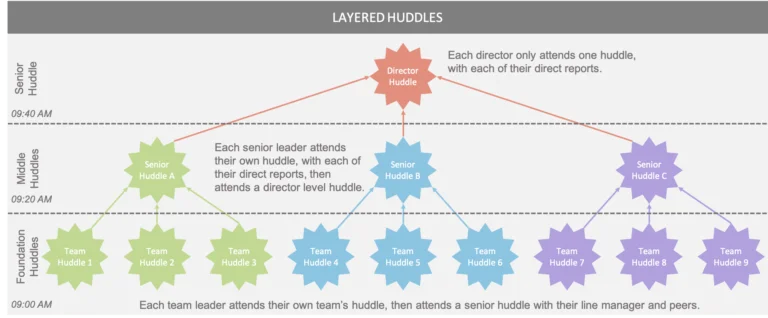Huddles or stand up meetings are short, sharp, focused, daily team meetings. They involve the whole team and take place around a physical or virtual information center. When done well they improve the performance and engagement of those attending. They can take place face to face, or virtually using a platform like Zoom.
Summary by The World of Work Project
Huddles or Stand Up Meetings
“Huddles”, ”stand up meetings” or “scrums” are short, sharp, focused, chaired, team meetings that take place daily and which often revolve around an information center or board, which acts as an agenda.
They can be face to face or virtual. They’re designed to ensure that team members remain focused and clear of their objectives, communicate effectively, understand delivery progress and risks, share best practice, recognize strong performance and identify gaps in activities and opportunities for improvement.
By getting people together to speak every day, huddles also help build team relationships and engagement.
Which Teams Benefit from Huddles?
In our view, nearly all types of teams benefit from having huddles.
We’ve delivered huddle training to multiple professional teams ranging from administrative, operational and change teams through to legal, finance, trading and actuarial teams. Across all these types of teams two things stand out in common.
The first is that nearly every team that we have started to train in the use of huddles says words to the effect of: “I can see how huddles would be really effective and helpful for most teams, but we’re different, so they might not work for us.”
The second is that after a suitable implementation period, and with the right type of support, nearly every team that we’ve trained to use huddles finds them hugely helpful. So much so that nearly all of them continue using them on a daily basis and can’t imagine working without them in the future.
What Benefits do Huddles or Stand Up Meetings Bring?
Huddling can bring a wide range of related and interconnected benefits to teams.
The specific benefits that different teams experience are often a product of the specific challenges they are facing. Broadly speaking though, introducing huddles or stand up meetings tends to provide two different types of benefits: harder, delivery related benefits and softer, people related benefits. Of course, these two types of benefits tend to reinforce each other, so separating them like this is slightly artificial.
Delivery Benefits
When effective, huddles materially improve clarity of purpose, prioritization, efficiency, task allocation, resource sharing, risk escalation, problem solving and communication within teams. They provide daily opportunities for teams to raise and discuss priorities, share and address risks and issues, reallocate attention as required and share information quickly and efficiently.
Huddles also often lead to time savings within teams. However, this initially appears counter-intuitive as they demand about 15 minutes every day from all team members. This 15 minute period should be thought of an as investment. In our view, it’s highly important that the time saved does not all result in reduced headcount. If fact, we’d say that about 75% of the time saved as a result of huddles should be reinvested into the teams that make those savings through a mixture of reducing excess hours and improving the quality of service that the teams provide.
People Benefits
As well as improving efficiency, huddles can also significantly improve communication, relationships and engagement within teams.
The simple act of bringing a team together at the same time every day and having an effective conversation about what the team is up to can be very powerful. This act greatly increases communication and transparency. It means that most people quickly become aware of the team’s wider deliverables, priorities, challenges and successes. As a result, individuals typically come together and support each other more as a team. In addition, individuals feel more well informed, more included, more listened to, more valued, more favorable towards their leaders and more satisfied with their employers.
Who Should Attend Huddles?
Huddles should be designed and implemented at a team level.
Broadly speaking, we would expect a huddle to be attended by a single leader or manager and the team members that report to them. The size of these teams will be shaped by an organization’s span of control, but we should suggest that a core huddle size should be between three and 15 people. The optimum size is usually between about 6 and twelve.
We would expect all of the members of the team that is huddling to attend every huddle. Though this isn’t always possible, it’s what we think teams should aim for.
In addition to the core members of the team attending, we also recommend that teams invite guests to their huddles from time to time. Specifically, we think that project managers, internal customers, internal suppliers and senior leaders should be invited to attend as guests.
Huddles are a great way to build relationships with these important stakeholders and to share information. Leaders particularly should attend huddles from their sub-teams where possible, as doing so helps them build effective relationships and understand how their teams are doing and the challenges they face.
What Levels of an Organization Should Huddle?
In our experience, huddles work most effectively at an organizational level when all levels of an organization use them. We recommend that huddles are implemented so that they are layered and escalating.
To do this, the most junior teams in an organization or division should huddle first, say at 09:00. The team leader of each of each of these huddles should then attend the next level up of huddle (with a more senior leader) once their own huddles have completed, say at 09:20. And then at 09:40 each of the senior leaders should get together for senior huddle with their director (or whatever language you wish to use).

This escalated approach to huddles provides a hugely effective way to introduce a streamlined communications and escalation route into organizations. Problems and risks can be identified, understood and escalated to senior levels in very brief periods of time. Likewise, information can flow the other way quickly as well as each team leader can share the outcomes of the more senior huddle with their core team in a timely fashion.
Learning More
Huddles help to improve motivation, employee experience and employee engagement. Over time they can increase trust, connection and psychological safety in teams. They can also reduce the chance of social threats and help team members spend more time in flow.
It’s important to learn what makes a good huddle and to learn how to chair huddles well. This simple guide to introducing huddles into your team might be helpful.
Many teams find huddles a key part of successful remote working.
You cna learn more about huddles in our podcast on them:
The World of Work Project View
We believe huddles bring huge benefits to teams including significant improvements in engagement and performance. We recommend that nearly every team at least experiment with using them. While they are most effective when they are stand-up and face-to-face, they can be nearly as effective for remote teams when virtual.
Huddles are fairly easy to implement, particularly if the team members are willing to try new things. They take time to get right though. Teams need to stick with it, provide feedback, learn from their mistakes and reflect on how to improve their huddles while they are getting used to them.
In summary, huddles are great. They yield far more benefits than we’ve discussed hear. You really should just put the effort in and do them.
How We Help Organizations
We provide leadership development programmes and consulting services to clients around the world to help them become high performing organizations that are great places to work. We receive great feedback, build meaningful and lasting relationships and provide reduced cost services where price is a barrier.
Learning more about who we are and what we do it easy: To hear from us, please join our mailing list. To ask about how we can help you or your organization, please contact us. To explore topics we care about, listen to our podcast. To attend a free seminar, please check out our eventbrite page.
We’re also considering creating a community for people interested in improving the world of work. If you’d like to be part of it, please contact us.
Sources and Feedback
The information in this post comes from our working experiences and there are no source materials to refer to.
We’re a small organization who know we make mistakes and want to improve them. Please contact us with any feedback you have on this post. We’ll usually reply within 72 hours.






